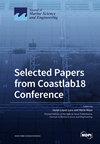Geometric Evaluation of the Hydro-Pneumatic Chamber of an Oscillating Water Column Wave Energy Converter Employing an Axisymmetric Computational Model Submitted to a Realistic Sea State Data
IF 2.8
3区 地球科学
Q1 ENGINEERING, MARINE
引用次数: 0
Abstract
In this research, considering the air methodology, an axisymmetric model was developed, validated, and calibrated for the numerical simulation of an Oscillating Water Column (OWC) converter subjected to a realistic sea state, representative of the Cassino beach, in the south of Brazil. To do so, the Finite Volume Method (FVM) was used, through the Fluent software (Version 18.1), for the airflow inside the hydro-pneumatic chamber and turbine duct of the OWC. Furthermore, the influence of geometric parameters on the available power of the OWC converter was evaluated through Constructal Design combined with Exhaustive Search. For this, a search space with 100 geometric configurations for the hydro-pneumatic chamber was defined by means of the variation in two degrees of freedom: the ratio between the height and diameter of the hydro-pneumatic chamber (H1/L1) and the ratio between the height and diameter of the smallest base of the connection, whose surface of revolution has a trapezoidal shape, between the hydro-pneumatic chamber and the turbine duct (H2/L2). The ratio between the height and diameter of the turbine duct (H3/L3) was kept constant. The results indicated that the highest available power of the converter was achieved by the lowest values of H1/L1 and highest values of H2/L2, with the optimal case being obtained by H1/L1 = 0.1 and H2/L2 = 0.81, achieving a power 839 times greater than the worst case. The values found are impractical in real devices, making it necessary to limit the power of the converters to 500 kW to make this assessment closer to reality; thus, the highest power obtained was 15.5 times greater than that found in the worst case, these values being consistent with other studies developed. As a theoretical recommendation for practical purposes, one can infer that the ratio H1/L1 has a greater influence over the OWC’s available power than the ratio H2/L2.采用轴对称计算模型的振荡水柱波浪能转换器水力气动室的几何评估,并提交真实海况数据
在这项研究中,考虑到空气方法,开发、验证和校准了一个轴对称模型,用于对振荡水柱(OWC)转换器进行数值模拟,该转换器处于现实海况下,代表巴西南部的卡西诺海滩。为此,通过 Fluent 软件(18.1 版)使用有限体积法 (FVM) 对 OWC 水气室和涡轮管道内的气流进行了模拟。此外,还通过构造设计与穷举搜索相结合的方法,评估了几何参数对 OWC 变流器可用功率的影响。为此,通过两个自由度的变化,为水力气动室定义了一个包含 100 种几何配置的搜索空间:水力气动室的高度和直径之比(H1/L1),以及水力气动室和涡轮风道之间旋转面为梯形的最小连接基座的高度和直径之比(H2/L2)。涡轮风道的高度和直径之比(H3/L3)保持不变。结果表明,H1/L1 值最小、H2/L2 值最大时,变流器的可用功率最大,最佳情况是 H1/L1 = 0.1,H2/L2 = 0.81,功率是最差情况的 839 倍。这些数值在实际设备中并不实用,因此有必要将变流器的功率限制在 500 千瓦,使评估更接近实际情况;因此,获得的最高功率是最坏情况下的 15.5 倍,这些数值与其他研究结果一致。作为一项实用的理论建议,我们可以推断,H1/L1 比 H2/L2 对 OWC 可用功率的影响更大。
本文章由计算机程序翻译,如有差异,请以英文原文为准。
求助全文
约1分钟内获得全文
求助全文
来源期刊

Journal of Marine Science and Engineering
Engineering-Ocean Engineering
CiteScore
4.40
自引率
20.70%
发文量
1640
审稿时长
18.09 days
期刊介绍:
Journal of Marine Science and Engineering (JMSE; ISSN 2077-1312) is an international, peer-reviewed open access journal which provides an advanced forum for studies related to marine science and engineering. It publishes reviews, research papers and communications. Our aim is to encourage scientists to publish their experimental and theoretical results in as much detail as possible. There is no restriction on the length of the papers. The full experimental details must be provided so that the results can be reproduced. Electronic files and software regarding the full details of the calculation or experimental procedure, if unable to be published in a normal way, can be deposited as supplementary electronic material.
 求助内容:
求助内容: 应助结果提醒方式:
应助结果提醒方式:


